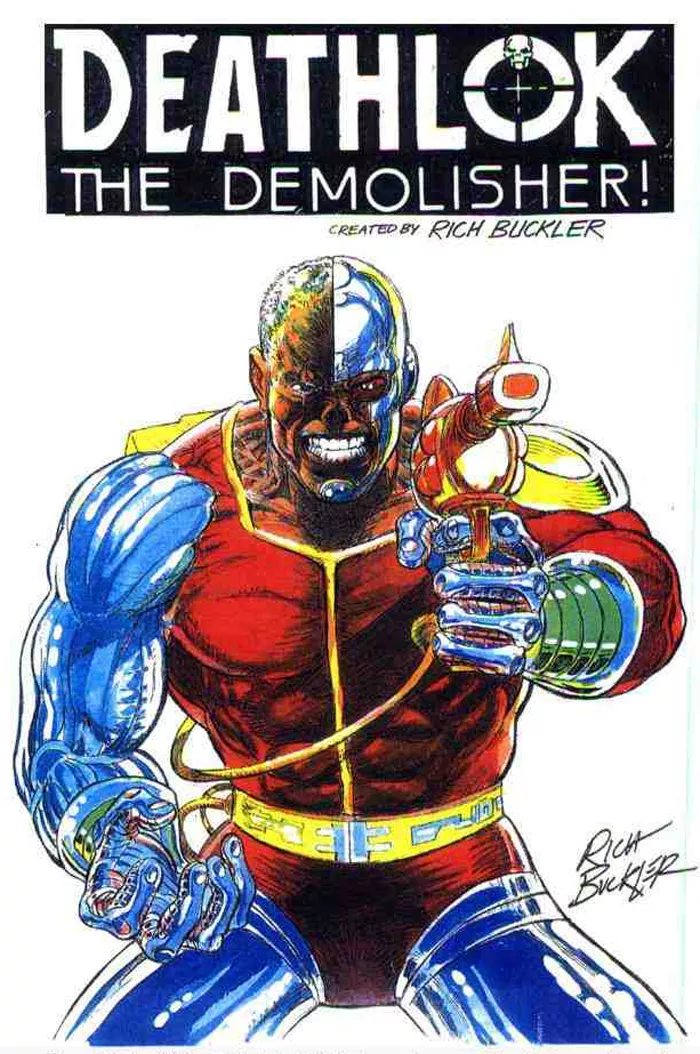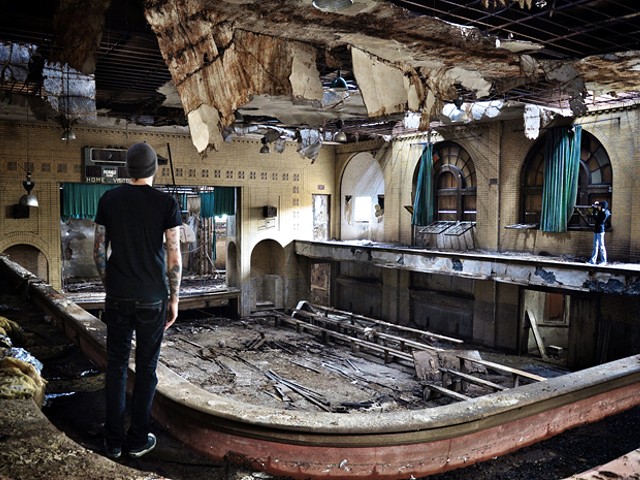When it was announced that a character called Deathlok was going to be appearing in the Marvel TV series Agents of Shield, not much was heard in the way of rejoicing, save for the muted voices of a few fanboys. Deathlok isn’t the most glamorous comic book character. He certainly doesn’t have the mainstream allure of a Spider-Man, Iron Man or Captain America, or even the “level one” cult appeal of a Hawkeye, Quicksilver or Ant-Man. There hasn’t been a Deathlok comic book in years, he’s largely forgotten, but listen up — he’s a badass. And he’s our badass.
Deathlok was created (or at least co-created) by Detroiter Rich Buckler, the man also responsible for the All-Star Squadron superhero team in the ’80s. The Deathlok name has been taken by a few different people, but the original was a character called Luther Manning, a soldier from Detroit who was fatally wounded in an explosion, and then reanimated as a cyborg. If that sounds a little like RoboCop, it’s because it is a little like RoboCop. Deathlok came first.
The Deathlok that was recently introduced to the Agents of Shield show (and therefore the ever-expanding Marvel Cinematic Universe) is not Manning but Mike Peterson, played by J. August Richards, a recurring character who lost his leg in an explosion and then reappeared in the episode “T.R.A.C.K.S.” with a cybernetic leg stamped “Project Deathlok.” In other words, the show’s creators have taken liberties with the character’s history. Still, Deathlok is rooted in Detroit.
Unfortunately, Buckler wasn’t contacted about the live action debut of his creation. “I’m not surprised,” he says. “Whenever Marvel has done anything with Deathlok, I always seem to hear about it after the fact. You would think they would do things differently, right? I did see the episode where they introduced the Deathlok character they are weaving into their storyline. Interesting, provocative … but not quite what I expected. They are not using the version I created. In this Agents of Shield version he is black. My character was a white man who was married to a black woman.”
It was on Agents of Shield that we finally saw a live-action Deathlok, but the idea of a movie has been making the rounds for a few years. “A few years ago there was a screenplay and a project in development,” Buckler says. “I don’t remember what movie studio was involved. The producers were having trouble attaching a director to the project. That’s what I heard anyway. I did get a sneak peek at the screenplay they were considering. There wasn’t much of anything I created for the Marvel Comics series that made it to the film script stage. No costume, no dialogue with his inner computer, nothing cybernetic or pertaining to cyborgs and programmed military assassins — nothing, really. Just the name Deathlok and his civilian name, Luther Manning. He was depicted as just a regular guy. The writer told me, somewhat apologetically, that what the producers were wary of was that Deathlok might appear to be a knockoff of Terminator. Ironic, isn’t it? Because Deathlok came first and so it’s really the other way around.”
By the end of the year, Deathlok won’t be the only Detroit-rooted superhero on the small screen. The other “big house,” DC Comics, has announced that there will be a pilot for scarlet speedster the Flash later this year, a spinoff of Arrow, and it will include the character Vibe, aka Francisco “Paco” Ramon, a street kid from the Motor City.
This is a real surprise, and we can thank Detroit native and current chief creative officer at DC Geoff Johns. Up until about a year ago, Vibe was considered a joke in the comic book world, often included in lists like “The worst superheroes of all time” because of his initially underwhelming ability to make things vibrate really fast.
Johns took on the task of reinventing Vibe as part of DC’s “New 52” reboot, giving him the ability to vibrate between dimensions. Vibe hooked up with an all-new Justice League of America (confusingly, a separate entity to the Justice League), and held his own. Thanks to Johns, Vibe is no longer an in-joke for longtime readers. We also have to assume that Johns played a part, at least indirectly, in getting Vibe onto the TV. He’ll be portrayed by Carlos Valdes.
We don’t know yet what Vibe will look like, and we don’t really know how Marvel’s Deathlok will evolve. The creators of both shows would do well do pay attention to Buckler though. “Go to the roots of the character,” he says. “Zero in on the original concept. Everything that made [Deathlok] unique and lasting is there in the original Astonishing Tales adventures. If they deviate from that, I’m sure the character will become diluted and ephemeral, like he did in the later Marvel appearances, and like so many of the films derived from comic books and superheroes that have gone south because the Hollywood producers didn’t do their homework. The successful superhero movie fare, those comic book-based films that became box office gold, those happened because the films’ creators understood the comics.
“So, OK, I understand that comics and film are two different media. Necessary changes will occur, and you can’t please everybody. But I think the superhero and comics-derived movies should be made by talented people who actually like and respect the source material.”
Still, any version of Deathlok and Vibe on the TV is better than none at all. Also, bear this in mind: The Marvel movie The Avengers ended with a scene featuring a character called Thanos, a really monstrous inter-galactic super-villain. Much of what will come, in movies like Guardians of the Galaxy and Avengers: Age of Ultron, will center on Thanos, who was created by a Detroit native, writer and artist Jim Starlin. Those movies will make billions, based on a Detroit creation.
There are also rumors that a future Amazing Spider-Man movie will feature a villain called Black Cat, another character created by a Detroiter, this time Keith Pollard. Throw in the fact that Superman vs. Batman (aka Man of Steel 2) is going to be filming here through the summer (at the time of writing, production had gotten underway in Metamora Township), and it becomes clear that, when it comes to live action comic book goings on, a lot is going on right here.
Speaking of Batman, Wayne State University Press is putting out a book about the ’60s Adam West series as part of its “TV Milestones” series. Batman, by University of Toledo film studies assistant professor Matt Yockey, dissects the show, taking a scholarly yet gleefully childlike approach.
Taken as a spoof, reruns of that old show are a treat, particularly in the shadow of the recent and very dark Chris Nolan trilogy. Sadly, the series still isn’t available on DVD (although the spinoff movie is), but Yockey’s book will fill a gap, as he discusses the social and cultural impact of the show and recalls moments of great humor (like when a tied-up Robin catches the bat-rope with his teeth, and Batman tells him that good dental health saved his life). The author digs deep, but it never feels like the tone is too heavy. The show was ludicrous, and Yockey has a blast getting playful with the themes and characters.
With Ben Affleck’s new Batman set to be all over metro Detroit this summer, it’s fitting that a local house has put out a book digging into the character’s less serious past.






